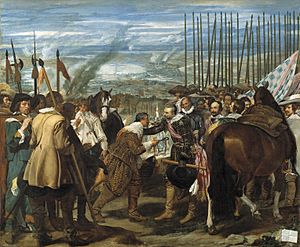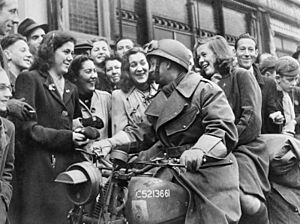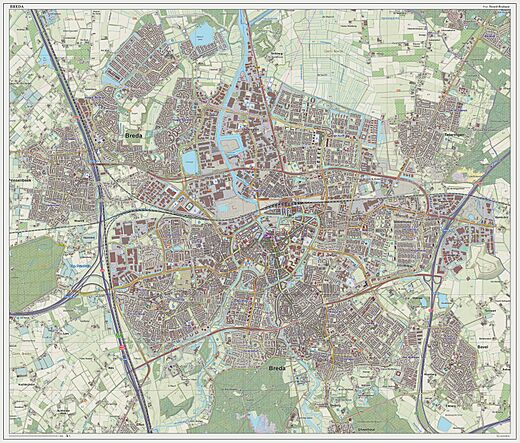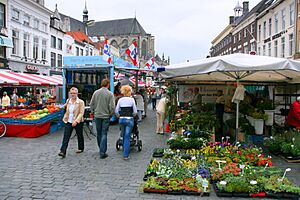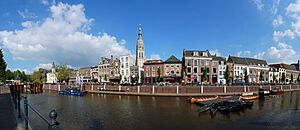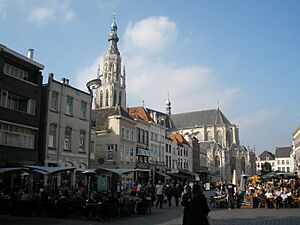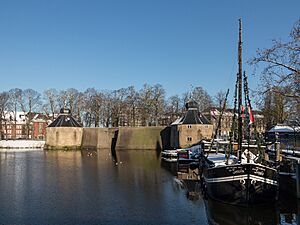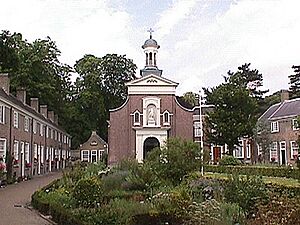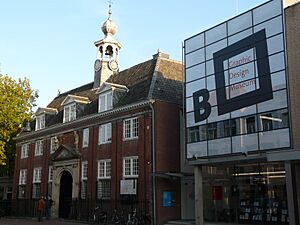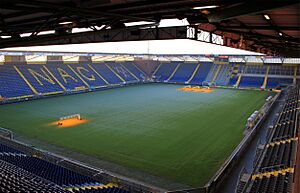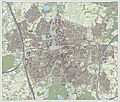Breda facts for kids
Breda (pronounced BRAY-duh) is a lively city in the southern part of the Netherlands. It's located in the province of North Brabant. The name "Breda" comes from "brede Aa," which means "wide Aa." This refers to where the Mark and Aa rivers meet. Breda is home to over 185,000 people and is one of the largest cities in the Netherlands.
For a long time, Breda was a very important city for military and political reasons because it was a fortified city. Through a marriage, the city became part of the House of Orange-Nassau, a very important family in Dutch history. This made Breda a central place for important events in the Low Countries.
Quick facts for kids
Breda
|
|||
|---|---|---|---|
|
City and municipality
|
|||
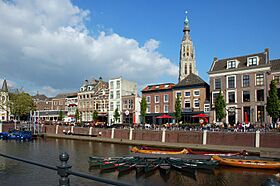
Docks in the city centre
|
|||
|
|||

Location in North Brabant
|
|||
| Country | Netherlands | ||
| Province | North Brabant | ||
| Government | |||
| • Body | Municipal council | ||
| Area | |||
| • Municipality | 128.68 km2 (49.68 sq mi) | ||
| • Land | 126.04 km2 (48.66 sq mi) | ||
| • Water | 2.64 km2 (1.02 sq mi) | ||
| Elevation | 3 m (10 ft) | ||
| Population
(Municipality, May 2014; Urban and Metro, May 2014)
|
|||
| • Municipality | 180,420 | ||
| • Density | 1,431/km2 (3,710/sq mi) | ||
| • Urban | 180,420 | ||
| • Metro | 324,812 | ||
| • Metro region [nl] | 553,706 | ||
| • Brabant CMSA | 1,932,055 | ||
| Demonym(s) | Bredanaar, Bredaër | ||
| Time zone | UTC+1 (CET) | ||
| • Summer (DST) | UTC+2 (CEST) | ||
| Postcode |
4800–4841, 4847, 4850–4854
|
||
| Area code | 076 | ||
| Click on the map for a fullscreen view | |||
Contents
History of Breda
Breda has a long and interesting history. In the 11th century, it was a special area ruled by the Holy Roman Emperor. The city was given a special charter in 1252. This meant Breda could build its own fortifications, like brick walls and gates.
In 1403, a woman named Johanna of Polanen married Engelbert I of Nassau. This marriage brought Breda into the hands of the powerful House of Orange-Nassau. This family played a huge role in Dutch history. Breda remained with this family until 1795.
Breda as a Royal City
Because the Orange-Nassau family lived in Breda, many other nobles also built beautiful homes there. The city grew quickly in importance. A large church, the Grote Kerk (Great Church), was built in a special Gothic style. Its tower is about 97 meters (318 feet) tall.
In 1534, a big fire destroyed most of Breda. Only about 150 houses and the main church were left.
During the Eighty Years' War, Breda was captured by Spanish troops in 1581. This was a difficult time for the city. In 1590, Dutch forces, led by Maurice of Nassau, Prince of Orange, took Breda back using a clever trick. Soldiers hid in a peat-boat to sneak into the city! The "Spanjaardsgat" (Spanish Gate) was built to remember this brave action.
Later, Breda was captured by the Spanish again in 1625. This event was even painted by the famous artist Diego Velázquez. But in 1637, Frederick Henry, Prince of Orange, recaptured the city. Finally, in 1648, Breda officially became part of the Dutch Republic.
Royal Guests and Important Treaties
Charles II of England, who was in exile, lived in Breda for a short time in 1660. He announced his conditions for becoming King of England from Breda.
Important agreements were signed in Breda. The Treaty of Breda ended a war between the Dutch and English in 1667. Later, talks in Breda helped end the War of the Austrian Succession in 1748.
World War II and Liberation
During World War II, Breda was occupied by German forces for over four years. On October 28, 1944, the city was liberated by the 1st Polish Armoured Division, led by General Maczek. Every year, Breda celebrates its liberation with Polish visitors. There is a museum and a monument in the city to honor General Maczek and the brave Polish soldiers. Many of them are buried in a nearby Polish military cemetery.
Breda also had one of the first panopticon prisons, called Koepelgevangenis. It held some German war criminals after World War II.
City Administration
Breda is a municipality that includes the main city and several smaller towns and villages. These include Prinsenbeek, Bavel, Teteringen, and Ulvenhout. The municipality is divided into 11 areas, like Breda Centre, Breda North, and Breda West.
City Map
Topographic map image of the city of Breda, March 2014. Click to enlarge.
Economy of Breda
In the past, Breda was known for its factories, especially in the food and drink industry. Famous companies like Hero (lemonade), Van Melle (Mentos), and Kwatta (chocolate) had their homes here. Breda also had the largest brewery in the Netherlands, Oranjeboom.
Today, Breda's economy is more focused on services, trade, and logistics. Many international companies have their main offices for the Benelux region in Breda. Some examples are 3M, Abbott Laboratories, General Electric, and Toshiba. The food industry is still important with companies like Hero Group and Perfetti Van Melle.
Breda is also home to the headquarters of the Royal Netherlands Air Force. Its location between the big ports of Antwerp and Rotterdam makes it a good place for logistics companies.
You can find great shopping in Breda's city center and southern areas. There are shopping centers like De Barones. A market is held on the Grote Markt every Tuesday and Friday.
Education in Breda
Breda is a big "education city" and "student city." In 2012, about 27,000 students were studying here.
There are different types of secondary education:
- Vmbo: Pre-vocational secondary education.
- Havo: Higher general continued education.
- Vwo: Preparatory scientific education (like Atheneum or Gymnasium).
Some schools even offer classes in both English and Dutch.
Breda also has vocational schools (MBO) and Universities of Applied Sciences (HBO). These include Breda University of Applied Sciences and Avans University of Applied Sciences. There's also the Koninklijke Militaire Academie (K.M.A.), which is a military academy for the Dutch Army and Air Force.
Main Sights in Breda
The city center of Breda is beautiful with old buildings and canals. The main square is the Grote Markt, full of cafes and pubs. Park Valkenberg is a large public park perfect for relaxing.
Some important historic buildings to see are:
- The Grote Kerk (Great Church), a stunning example of Gothic architecture.
- The Castle of Breda, which is now home to the military academy.
- The Bouvigne Castle.
- The Begijnhof, a historic courtyard with small houses.
- Saint Anthony's Cathedral.
- The City Hall.
- The Spanjaardsgat, a 16th-century water gate.
- The Koepelgevangenis (Breda) (Koepelprison), known for its unique round shape.
Culture in Breda
Breda has a rich culture, especially known for its lively Carnaval celebrations.
Like many cities in the south of the Netherlands, Breda celebrates Carnaval about 40 days before Easter. It's a four-day party filled with silly costumes, music, and fun. During Carnaval, the city's name is playfully changed to 'Kielengat'. There are parades with colorful floats and music bands.
Arts and Entertainment
Breda has many places for arts and entertainment:
- Chassé Theater: A large theater for plays and concerts.
- Nieuwe Veste: An art and music center.
- Poppodium Mezz and Poppodium Phoenix: Concert venues for live music.
- Chassé Cinema and Pathé Breda: Movie theaters.
Music Festivals
Breda hosts many exciting music festivals throughout the year:
- Breda Jazz Festival: A popular jazz event.
- Breda Barst: A free rock festival.
- Breda Live and Breda Dancetour: Big dance festivals.
- Spanjaardsgat Festival: Classical music on a floating stage.
- 538 Koningsdag: A huge party for the King's birthday.
Museums
You can learn a lot about Breda's history and culture at its museums:
- Begijnhof Breda Museum: About the historic Begijnhof.
- Generaal Maczek Museum: Dedicated to General Maczek and the Polish liberation.
- Stedelijk Museum Breda: The main city museum.
- NAC Museum: About the local football club.
Other Events
- BredaPhoto: An outdoor photo exhibition.
- Graphic Matters: A graphic design festival.
- Lichtsloepen Parade: A parade of illuminated boats.
Redhead Day
Redhead Day (Roodharigedag) was a festival held in Breda for people with natural red hair. It also featured art related to the color red. It attracted people from many countries and was free to attend. The festival has since moved to Tilburg.
Sports in Breda
Breda is a city that loves sports!
Football
Breda's professional football club is NAC Breda. They play in the Eredivisie, the top Dutch league, at the Rat Verlegh Stadion. NAC Breda even won the national championship once in 1921! There are also many amateur football clubs in Breda.
Hockey
Hockey is also very popular in Breda. The club B.H.V. Push has produced many talented players who have played for the Dutch national teams.
Athletics
Breda's athletics club, A.V. Sprint, is one of the largest in the Netherlands with about 2000 members. They offer various sports, including track and field, nordic walking, and even parasports.
Other Sports
Breda offers many other sports like water polo, swimming, rugby, kickboxing, and bowling. The military academy also has its own rowing and sailing club.
Sport Events
- Singelloop: Every October, Breda hosts a big running event called the Bredase Singelloop, including a half marathon.
- Outdoor Brabant: This is a large equestrian (horse) sports event with dressage, eventing, and show jumping.
Para Sports
Breda is a big supporter of para sports (sports for people with disabilities):
- In 2024, Breda and Tilburg will host the Special Olympics National Games. This is a huge event for athletes with intellectual disabilities.
- The European Para Championships were held in Breda in 2023, with 1500 athletes from 45 countries.
- In 2011, the ParaGamesBreda welcomed 3000 athletes from 40 countries.
UEFA Women's Championship 2017
The Rat Verlegh Stadion in Breda was one of the host stadiums for the UEFA Women's Championship in 2017. The Dutch women's team won the tournament!
Demographics of Breda
Religion
Religions in Breda (2014) No affiliation (44.9%) Roman Catholic (41.8%) Protestant Church in the Netherlands (6.0%) Other Christian denominations (2.6%) Islam (3.6%) Hinduism (0.6%) Buddhism (0.5%)
In 2014, most people in Breda were Christian (50.4%). About 3.6% of residents followed Islam. A large group, 44.9%, did not have a religious affiliation.
Ethnic Groups
Breda is a diverse city. In 2020, about 75.45% of the population was Dutch. Other significant groups included people from Morocco, Indonesia, Turkey, Belgium, and Germany.
Famous People from Breda
Many notable people have connections to Breda:
- Charles II of England: Lived in Breda during his exile.
- William the Silent: A key figure in Dutch history and Prince of Orange, he lived at the Breda Castle.
- René Descartes: The famous philosopher and mathematician had important conversations in Breda that changed his life's direction.
- Colonel Tom Parker: Elvis Presley's manager, was born in Breda.
- Tiësto and Hardwell: World-famous electronic dance music DJs are from Breda.
- Virgil van Dijk: A well-known Dutch professional footballer.
- Sylvie Meis: A Dutch television personality and model.
- Pieter Bruegel the Elder: A famous Netherlandish painter.
- Kazuha Nakamura: A Japanese singer and dancer from the group Le Sserafim, who grew up in Breda.
Getting Around Breda
Breda has good transportation options.
Trains
Breda has two train stations: Breda and Breda-Prinsenbeek. You can take regional trains (Sprinter) and intercity trains to many cities across the Netherlands, like Rotterdam, Amsterdam, Eindhoven, and Vlissingen. There's also a high-speed train, the 'Intercity direct', connecting Breda to Rotterdam, Schiphol Airport, and Amsterdam. An international train also connects Breda to Brussels.
Buses
Breda has city buses, regional buses, and even international buses. City buses help you get around Breda itself. Regional buses connect Breda to nearby towns. 'Brabantliner' intercity buses offer more comfortable rides to cities like Gorinchem and Utrecht.
You can also take international buses from Breda to places like Paris, Brussels, and even Bucharest!
Roads
Major highways connect Breda to other important cities. The A16/E19 goes north to Rotterdam and south to Belgium (Antwerp and Brussels). The A27/E311 goes north to Utrecht. The A58 connects Breda to Tilburg and Eindhoven in the east, and Roosendaal and Vlissingen in the west.
Waterways
Breda's rivers, the Mark and Aa, were important for trade long ago. Today, you can use the waterways for pleasure boating. The city is connected to larger canals and rivers, allowing boats to reach the city center.
Airport
Breda International Airport is a small airport west of the city. It's mainly used for business trips, sightseeing, and flight training.
Sister Cities
Breda is twinned with several cities around the world. This means they have special friendly relationships:
Images for kids
See also
 In Spanish: Breda para niños
In Spanish: Breda para niños







